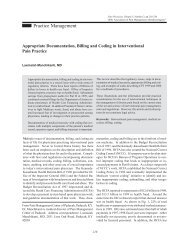ASIPP Practice Guidelines - Pain Physician
ASIPP Practice Guidelines - Pain Physician
ASIPP Practice Guidelines - Pain Physician
You also want an ePaper? Increase the reach of your titles
YUMPU automatically turns print PDFs into web optimized ePapers that Google loves.
Manchikanti et al • <strong>ASIPP</strong> <strong>Practice</strong> <strong>Guidelines</strong><br />
43<br />
nerve root block was the first term developed to describe<br />
the technique for diagnosing the source of radicular pain<br />
when imaging studies suggested a possible compression<br />
of several roots. Early studies of selective nerve root injections<br />
described an extra-foraminal approach, in which<br />
the needle is advanced at a right angle to the spinal nerve<br />
outside the neural foramina. Subsequently, a variation of<br />
this procedure has emerged which has been termed selective<br />
epidural and is also referred to as transforaminal epidural.<br />
Sacroiliac Joint Injections<br />
Sacroiliac joint has regained interest as a primary source<br />
of low back pain in recent years, but confirming the diagnosis<br />
of sacroiliac joint dysfunction and pain remains difficult.<br />
Even though intra-articular sacroiliac joint injections<br />
have provided information on pain referral patterns<br />
(166, 167, 359), detecting symptomatic joints in patients<br />
presenting with low back pain continues to be a difficult<br />
venture (358, 360-371). Thus, provocative injections remain<br />
the only direct method to distinguish symptomatic<br />
from asymptomatic joints. Schwarzer et al (191), utilizing<br />
single local anesthetic block reported a prevalence of 30%<br />
in chronic low back pain population. Maigne et al (192),<br />
utilizing a double block paradigm with comparative local<br />
anesthetics reported prevalence in chronic low back pain<br />
population of 19% with a false-positive rate of 29%.<br />
An Algorithmic Approach<br />
Two suggested algorithms for the application of interventional<br />
techniques in conservative care of chronic spinal pain<br />
describing steps for diagnosis and management are shown<br />
in Fig. 3 and 4. These are only suggested algorithms and<br />
are limited to the management of chronic spinal pain. Further,<br />
clinical evaluation in spite of drawbacks is extremely<br />
important, as is the documentation of indications for interventional<br />
techniques.<br />
The clinical algorithms presented on the following pages<br />
show an effort to blend conscientious, explicit, and judicious<br />
use of the current best evidence in making decisions<br />
about the care of individual patients. When this is combined<br />
with the clinician’s experience and judgment, and<br />
patient preferences, it should result in improved outcomes<br />
and significantly improved quality of care. These guidelines<br />
are intended to establish a boundary of reasonable<br />
care giving latitude to the individual physician.<br />
THERAPEUTIC INTERVENTIONAL<br />
Rationale<br />
TECHNIQUES<br />
The rationale for therapeutic interventional techniques in<br />
the spine is based upon several considerations: the cardinal<br />
source of chronic spinal pain, namely discs and joints,<br />
are accessible to neural blockade; removal or correction<br />
of structural abnormalities of the spine may fail to cure<br />
and may even worsen painful conditions; degenerative processes<br />
of the spine and the origin of spinal pain are complex;<br />
and the effectiveness of a large variety of therapeutic<br />
interventions in managing chronic spinal pain has not been<br />
demonstrated conclusively (27-32, 66-69, 261-291, 421-<br />
456). Tulder et al (421) evaluated conservative treatment<br />
of chronic low back pain and studied the evidence for effectiveness<br />
of numerous conservative modalities used in<br />
managing chronic low back pain, including drug therapy,<br />
manipulation, back schools, electromyographic biofeedback<br />
therapy, exercise therapy, traction and orthoses, behavioral/cognitive/relaxation<br />
therapy, and transcutaneous<br />
electrical nerve stimulation. Overall results were highly<br />
variable for various conservative modalities of treatment<br />
in managing chronic low back pain. They have not studied<br />
either the differences between various types of epidural<br />
steroid injections, or lysis of adhesions. In addition,<br />
they also omitted facet joint injections, facet joint nerve<br />
blocks, and medial branch neurotomy. Similarly, surgical<br />
treatment of lumbar disc prolapse and degenerative lumbar<br />
disc disease was also without conclusive evidence<br />
(290). There are a multitude of interventional techniques<br />
in the management of chronic pain which include not only<br />
neural blockade but also minimally invasive surgical procedures<br />
ranging from peripheral nerve blocks, trigger-point<br />
injections, epidural injections, facet joint injections, sympathetic<br />
blocks, neuroablation techniques, intradiscal thermal<br />
therapy, disc decompression, morphine pump implantation,<br />
and spinal cord stimulation.<br />
In developing these guidelines, we have evaluated the effectiveness<br />
of the most common interventional therapeutic<br />
interventions for chronic pain in general, and specifically<br />
chronic spinal pain. Koes et al (66) concluded that<br />
the methodological quality of clinical trials of the efficacy<br />
of the commonly used interventions in low back pain was<br />
disappointingly low. For these guidelines, a modest approach<br />
including a blend of scientific evidence together<br />
with expertise and consensus was utilized. All the trials<br />
were scored according to the criteria described (45).<br />
Whenever applicable, we used the original scores of pre-<br />
<strong>Pain</strong> <strong>Physician</strong> Vol. 4, No. 1, 2001
















